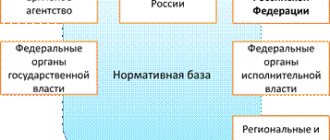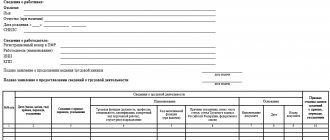Why is it necessary to maintain employee records?
As soon as an enterprise is registered, information about it is transferred to the military commissariat (see paragraph 19 of the “Rules for maintaining the Unified State Register of Legal Entities and providing the information contained therein”, approved by Decree of the Government of the Russian Federation of June 19, 2002 No. 438). The maximum period for transferring information about a new company is five days from the moment it is entered into the Unified State Register of Legal Entities - this is the responsibility of the registration authority, so “people in uniform” can come to the employer with a check at any time.
Therefore, all companies, regardless of their form of ownership, are required to keep military records of their employees (subclause 6, clause 1, article 8 of the Federal Law of May 31, 1996, No. 61-FZ, clause 7, article 8 of the Federal Law, dated March 28, 1998. No. 53-FZ) and promptly report information about them to the military commissariat.
Features of filling out Form 18 for submission to the military registration and enlistment office
The time has come for organizations of all forms of ownership in the country to submit military registration reports. For this, Form 18 is used for the military registration and enlistment office; the 2020 form can be downloaded on the official websites of city government bodies. Similar sites also contain instructions on how to fill out this document.
This is interesting: Kbk ffoms un for yourself 2020
Why do you need an organization registration card form 18?
In essence, this is a report that contains the main indicators of the results of maintaining military records and booking of citizens who are in reserve.
Organizations according to the method of accounting are divided into two types:
- to the leading simple control unit;
- for companies that make reservations for citizens who are in reserve.
Higher education institutions carry out educational training for employees, final year students and graduate students.
Form 18 is filled out every two years and submitted to the military registration and enlistment office by December 31 of the current year as of January 1 of the next year.
Military registration form book 13
This is a book on recording special military registration forms. Its form is approved by the Government of the Russian Federation and the Ministry of Defense.
It states the following:
- date of receipt or delivery of forms;
- Full name and position of the employee from whom the forms were accepted or to whom the forms were issued;
- arrival: number of forms, their numbers and series;
- consumption: number of notices and certificates issued;
- balance: the remaining number of certificates and notices.
The book must be numbered and bound. It is certified by the head of the organization and the employee responsible for maintaining military records.
Where is it provided?
The organization's registration card is drawn up in triplicate and filled out on both sides. The completed document is signed and certified by the director of the enterprise. After this, the form is sent to:
- the first copy – to the regional reservation commission;
- the second - to the military registration and enlistment office;
- the third - to the archive of the enterprise.
If the card is presented to the district reservation commission for the first time, it is registered in the registration register. A mark to this effect is placed on all copies. The registration number must correspond to the number of the entry in the journal.
A letter code A or B is also assigned:
- A - only control is carried out;
- B - military registration and reservation of citizens who are in reserve are carried out.
Information for filling out the card
Before filling out the card, you must determine which of the two types the organization belongs to:
- deals only with maintaining military records;
- also carries out reservations for citizens staying in reserve.
Educational organizations of higher professional education indicate not only employees, but also penultimate and final year students, as well as full-time graduate students.
The card is filled out by the person responsible for maintaining military records at the enterprise. The document is printed in triplicate and signed by the head of the company with the obligatory decoding of the signature. At the end of the document the date of compilation and stamp are indicated.
All copies are submitted to the district commission for the reservation of citizens. After verification, the cards are registered in the registration journal, the assigned number is affixed to each copy. The entry numbers in the journal and on the forms must match. The second copy is sent to the military commissariat, the third is returned and kept in the organization’s file.
This is interesting: The weakest chemical bond in a molecule
Procedure for filling out the document
The organization’s registration card, form No. 18, is contained in the Letter of the Ministry of Culture of the Russian Federation dated October 21, 2015 N 344-01-39-VA “On the provision of an organization’s registration card.”
The organization's registration card, the form of which must be filled out by all organizations without exception, must contain:
- date of completion;
- registration number;
- information about the manager (position, full name);
- information about the employee who carries out the VU in the organization (position, full name);
- information about the company (name, date, place of registration, legal address, actual and postal address, main OKVED codes, INN, OGRN, etc.);
- information about employees in reserve;
- and other information.
When booking citizens who are in reserve, the card indicates: the number of reserved citizens who are in reserve, the number and section of the list of positions and professions for which citizens are booked.
The completed document is signed by the manager and certified with a seal.
Military registration: filling out form 6
This is a report on the number of active and reserved employees in an organization. It is filled out in accordance with the rules of the Interdepartmental, district and territorial commissions for the reservation of gas reserves.
The category of working employees indicated in column “A” includes:
- Line 1: heads of state authorities, local government, structural divisions.
- Line 2: workers in engineering, research, management, and economic specialties.
- Line 3: livestock specialists, veterinarians, agronomists, land managers and specialists who work at agricultural enterprises and their subsidiary farms.
- Line 4: specialists who work in the field of mining.
- Line 5: manufacturing workers.
- Line 6: employees of organizations producing and distributing gas, electricity and water.
- Line 7: construction workers.
- Line 8: employees of transport companies;
- Line 9: education system specialists, cadets, final year students of educational institutions, graduate students (studying in full-time graduate school).
- Line 10: Health system employees.
- Line 11: employees of enterprises of other types of economic activity.
- Line 12: clerks, cashiers, archivists, timekeepers, secretaries.
- Line 13: all workers (sum term 14-19).
- Line 14: working tariff categories, except those indicated in lines 16-19.
- Line 15: working non-tariff categories, except those indicated in lines 16-19.
- Line 16: employees of crop and livestock enterprises, as well as other production sectors of agriculture.
- Line 17: drivers and assistant drivers.
- Line 18: drivers.
- Line 19: tractor drivers, bulldozer drivers, scraper drivers, grader drivers.
- Line 20: air traffic crew employees.
- Line 21: crew members of watercraft.
- Line 22: total of lines 1, 2, 12, 13.
- Line 23: fill out columns 1-5 and 9-11, which include information from Form 18 accounting cards.
- Line 24: sum of lines 22-23.
After this, they move on to filling out other parts of the report.
Next comes the column “Total employees”. It indicates all working men and women of military age who are exempt from military duties in peacetime and war. Also included in this category are cadets and students of state educational institutions; working part-time or seasonally.
Column 2 – “Total in reserve.” It indicates sergeants, sailors, midshipmen, foremen, and warrant officers. It should reflect the sum of columns 3-4.
The number of GPZ does not include:
- citizens of the age limit for being in the reserve;
- removed from military registration;
- persons of military age.
Column 6: “Total booked.” It reflects the sum of columns 7 and 8. It indicates the number of reserved military personnel who will be deregistered after January 1 of the next year based on their achievement of a certain age.
Column 9: “The number of unreserved gas stations that do not have MP.” It reflects the number of unbooked gas stations that do not have mobilization orders.
Column 10: “Number of unbooked gas stations with MP.” It indicates the number of citizens who have mobilization orders.
Column 11: “Citizens subject to conscription for military service.” This category includes citizens of military age who have a certificate confirming that they are eligible for military service.
Column 12: “Note”. It contains Form 19 information.
When drawing up a report, organizations must check the military registration data of T-2 cards. They must also cancel the draft deferments of reserved citizens who have lost the right to a deferment from military service.
Description of design
The KS-18 had a bonnet, front-engine, rear-wheel drive automobile layout. The engine-transmission compartment was located in the bow of the hull, the control compartment was located in the middle; Behind the control compartment there was a tank for chemical warfare agents. The vehicle's crew consisted of two people (a driver and a commander, who also served as a gunner); boarding and disembarking was carried out through two side doors that opened to the rear.
Armored hull and deckhouse
The armored body of the vehicle was made of rolled steel armor plates 4-8 mm thick and had a box-like shape with a strongly protruding deckhouse. The bow of the armored hull had a stepped shape and consisted of a top sheet that formed the forehead of the control compartment, a middle sheet installed at an angle close to horizontal and formed the roof of the engine-transmission compartment, and a bottom sheet that formed the forehead of the engine-transmission compartment. To access the engine-transmission compartment, its side armor plates had two rectangular hatches that opened upward. Behind the wheelhouse was an armored chemical tank.[1][2]
Armament
The vehicle's small arms consisted of one 7.62 mm tank machine gun mounted in a ball mount in the frontal armor plate of the control compartment on the left.[1][2]
Chemical equipment
The machine was equipped with special chemical equipment of the KS-18 brand and a tank with a capacity of 1000 liters. Depending on the substance filling the tank, the vehicle could perform various tasks - setting up smoke screens, degassing the area, or spraying chemical warfare agents.[1][2]
Setting up smoke screens
was carried out using a mixture of S-IV. When the tank was completely filled, the mixture was sufficient for 25-30 minutes of continuous operation.[1][2]
Degassing of the area
was carried out using a spray column. A fully filled tank was enough to process 2600 m².[1][2]
Infection of the area
The OM was carried out using a special horseshoe-shaped sprayer, which provided a spray strip 25 m wide.[1][2]
Surveillance and communications equipment
The crew of the vehicle carried out observation through three viewing slits, located one each in the frontal armor plate of the control compartment and in the side armor plates above the doors.
To provide external communications, a 71-TK radio station with a handrail antenna was installed on the vehicle.[1][2]
Chassis
The vehicle's chassis is wheeled, with a 6 × 4 wheel arrangement. The vehicle's suspension is dependent on semi-elliptic leaf springs.[1][2] To increase cross-country ability, the vehicle was equipped with quick-release Overall caterpillar tracks, transported on the rear wings[3].
Electrical equipment
Electricity consumers included a radio station, as well as two headlights mounted above the fenders and a brake light. There was also a small charger to extend the work.
What kind of document is this - form KS-18
KS-18 is one of the unified forms of the primary report, which is included in the album approved by State Statistics Committee Resolution No. 100 dated November 11, 1999. On its basis, an act on the suspension of design and survey work within the framework of construction projects is drawn up.
The document is drawn up in cases where design and survey work is not completed due to a stop in construction or does not begin in principle due to the fact that it is not included in the final estimate of the project.
The act in form KS-18 is drawn up by the customer. In this case, 3–4 copies of the document are made. One of them is transferred to the accounting department of the customer company, 2 are sent to the entity engaged in project activities. Another copy of the act may be requested by the investor.






